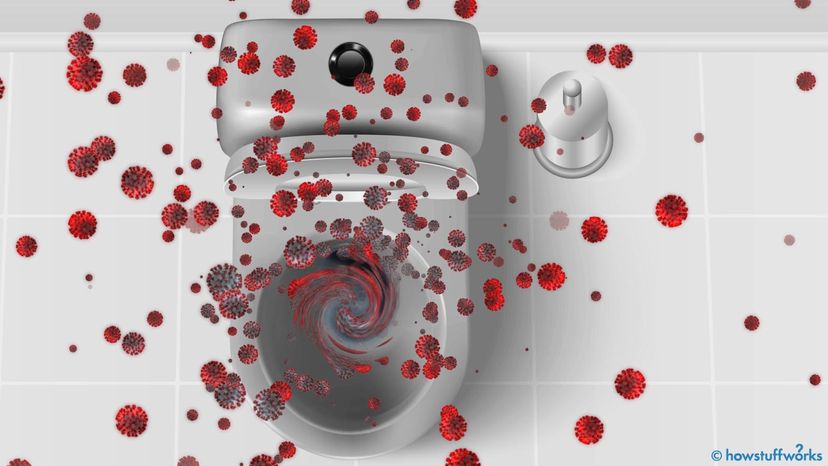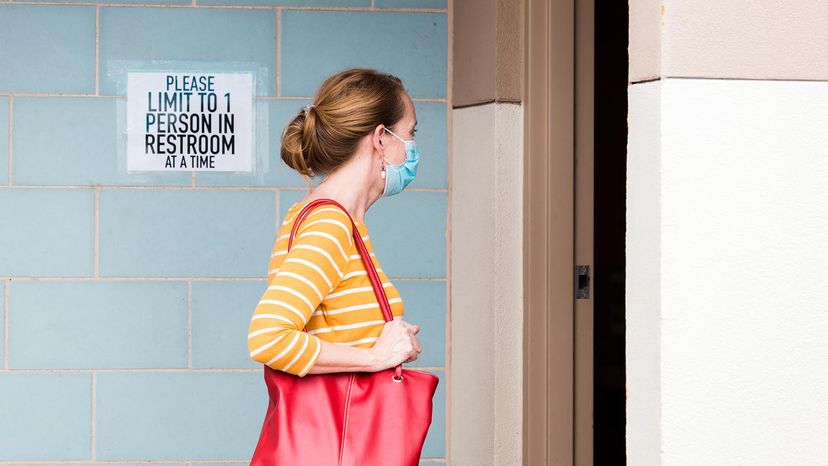 “Could coronavirus particles be floating all over the public bathroom stall you simply have to use? If so, how can you be sure you won’t be exposed? gomolach/Shutterstock/HowStuffWorks
“Could coronavirus particles be floating all over the public bathroom stall you simply have to use? If so, how can you be sure you won’t be exposed? gomolach/Shutterstock/HowStuffWorks
Let’s talk public bathrooms. Because even during a global pandemic that from the outset has had experts touting preventative measures like washing our hands and sanitizing surfaces, you could still find yourself in need of a public restroom. And now more than ever, it’s vital to understand what constitutes a safe bathroom experience — and what should signal danger.
But not only that: What about the future of public bathrooms? Will they require updating and overhauls to meet the higher standard of hygiene?
"In the wake of COVID-19, we need to rethink the layout and design of public bathrooms to address the space needed to accommodate social distancing guidelines," James Walsh, vice president of commercial products at the 140-year old plumbing and fixtures company American Standard, says in an email. "The way we look at health and hygiene is different now than just three months ago."
The Problem With Public Spaces
Although the Centers for Disease Control and Prevention (CDC) has stated that you can get COVID-19 by touching surfaces or objects that have coronavirus on it, it’s not considered to be the main way the virus spreads. Nevertheless, the CDC says washing your hands or using hand sanitizer frequently — and regularly cleaning and disinfecting surfaces — is one of the best ways to prevent spread.
And therein lies the problem. We don’t have control of how often surfaces are cleaned in public bathrooms. But you can practice safe behaviors if you have to use one. William Petri, professor of medicine at the University of Virginia, writes in The Conversation that if you use a public restroom, you should touch as few surfaces as possible — and avoid touching your eyes, nose or mouth. After you go, wash your hands for at least 20 seconds, and skip the hand dryer because they can create aerosols.
Of course there is so much focus on social distancing as the best tool to avoid spreading coronavirus, but it’s nearly impossible to stay 6 feet (2 meters) away from people in a tiny bathroom. What’s worse is coronavirus particles can linger in the air of tight spaces (like a bathroom) for several hours. That means, if the person who uses a stall before you coughed and left coronavirus particles floating around, those particles could still be in the air when it’s your turn.
"Scientists still don’t know how much of the virus you have to take in to become infected, but it’s better to be safe than sorry," Petri wrote. "Limiting the amount of time spent in any enclosed indoor space — restrooms and restaurants included — can reduce the potential for getting sick from the coronavirus." Wearing a mask in a public bathroom is another good precaution.
But surfaces and air particles may not even be the worst of it.
 “Limiting the number of people allowed at one time, and requiring everyone that uses them to wear a mask, can make public bathrooms safer. SDI Productions/Getty Images
“Limiting the number of people allowed at one time, and requiring everyone that uses them to wear a mask, can make public bathrooms safer. SDI Productions/Getty Images
Eww, Toilet Plumes
A March 2020 study published in the journal The Lancet suggests that someone infected with coronavirus could shed the virus through their feces for nearly five weeks after their respiratory samples test negative. While researchers acknowledge that respiratory transmission is still the primary route, they recommend more exploration into the "viability of infectivity" of coronavirus via feces.
What’s more, flushing the toilet can aerosolize, well, what’s in it, launching particles of fecal waste into the air — what’s known as "toilet plume." A second study, published June 16, 2020, in the Journal Physics of Fluids confirmed toilet plume aerosols and found that 40 to 60 percent of aerosol particles reached well above the toilet seat.
"Toilets are a daily necessity but also become dangerous if used improperly, especially against the current scenario of a global pandemic," Y. Li and J.-X. Wang, authors of the Journal Physics of Fluids paper, wrote.
If the coronavirus can be shed for weeks in the feces of a person who’s recovered from the illness, that toilet plume could carry the virus into the air, where it could remain trapped in the stall until the next user arrives. But remember, as Petri noted, we still don’t know how long that lingering virus could potentially infect someone.
How Public Restrooms Must Change
One easy, temporary solution to making public bathrooms safer would be to limit the number of people who can use them at the same time, Walsh says.
Li and Wang said they advocate several steps we can take as well:
- Clean the toilet seat with a disinfecting wipe before you use it. This can eliminate virus particles that might have settled on its surface.
- If the toilet has a lid, close it before you flush to prevent toilet plume.
- Finally, wash your hands carefully after flushing, since virus particles may be present on the flush button and door handle.
American Standard’s Walsh says he expects the overall layout and shape of commercial bathrooms to change to address the spacing issue required to accommodate social distancing. Sinks and stalls will eventually be installed at a minimum of 6 feet (2 meters) apart, and technology will be used to eliminate the need to touch things like faucets and flush handles.
"Changes are necessary across the board to keep everyone safe," Walsh says. "Our team is working to improve the reliability with proximity and automatic technology, targeting auto open/close toilet seats, auto flush toilets and urinals alike, as well as auto handwashing faucets."
The good news is that these innovations have already been developed. Many features like automatic toilet lids and auto-cleaning functionality are already available in home bathrooms. Walsh says American Standard is looking for ways to extend its existing self-cleaning toilet technology, like the ActiClean and VorMax, to commercial toilets, urinals and lavatories.
"’Before’ these types of upgrades could wait; now they can’t," Walsh says. "For instance, touchless faucets are almost always recommended by engineers for public consumer spaces, but many businesses or building managers opt for a standard faucet to save on cost. Now, we will likely see touchless technology required in these spaces, instead of presented as an upgradeable option."
Now That’s Interesting
Medieval European castles included toilet rooms called "garderobes" that protruded from the wall and dropped waste directly into the moat below.

